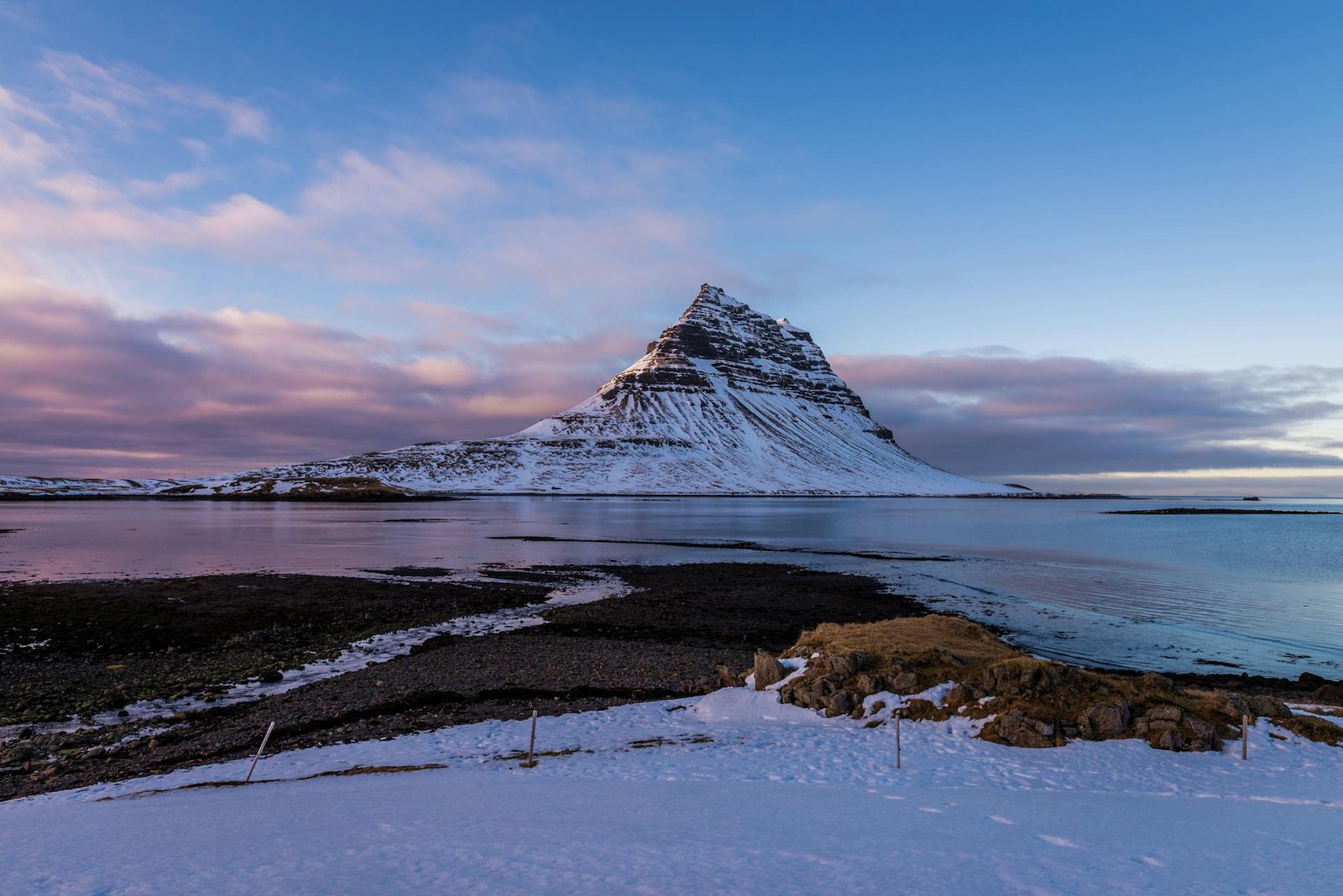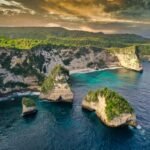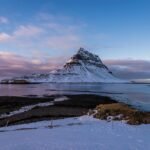Iceland is famous for its waterfalls and dramatic scenery. Many people dream of visiting in summer, when days are long and the weather is milder. But winter in Iceland has its own magic. Snow-covered mountains, frozen waterfalls, and the chance to see the Northern Lights make the colder months a truly special time to visit.
If you are thinking about traveling to Iceland in winter, it helps to know what to expect. This guide explains the weather, daylight, activities, and practical tips for exploring the country during its coldest season.
Winter Weather in Iceland
Winter in Iceland lasts from late November through March. The temperatures are cold but not as extreme as many people imagine. In Reykjavik, the capital, average winter temperatures range between -1°C and 4°C (30°F to 39°F). It feels colder outside the city, especially with strong winds, but heavy snow is less common than you might expect.
Because Iceland is surrounded by the North Atlantic Ocean, the climate is milder than in some inland northern countries. However, weather changes quickly. Sunshine, snow, rain, and wind can all happen in one day. Travelers need to be ready for sudden changes and always dress in layers.
Daylight Hours in Winter
One of the biggest differences in visiting Iceland in winter is the limited daylight. In December, the shortest month of the year, Reykjavik gets only about four to five hours of daylight per day. The sun rises late in the morning and sets by mid-afternoon.
While this may seem like a challenge, it creates a unique atmosphere. The long hours of twilight mean the sky often glows with pink and purple colors, making the view even more dramatic. By February and March, daylight increases quickly, giving you closer to ten hours of light.
Planning your activities around daylight is important. Many travelers use the short days to see key sights and spend the long evenings enjoying cozy cafes, hot springs, or guided tours of the Northern Lights.
The Northern Lights
The Northern Lights, or Aurora Borealis, are one of the top reasons people visit Iceland in winter. These colorful lights dance across the sky on clear, dark nights. While they are never guaranteed, winter gives you the best chance to see them because the nights are long and dark.
The best months for viewing are from late September to early April. To increase your chances, head away from city lights. Guided tours leave from Reykjavik and take visitors to rural areas with the best conditions. You can also rent a car and drive yourself if the weather is safe.
Patience is important, as the lights don’t appear on schedule. Sometimes they show up as faint green glows, while other times they burst into bright, moving waves of green, pink, and purple. Seeing the Northern Lights is often described as a once-in-a-lifetime experience.
Winter Scenery and Sights
Iceland’s natural beauty looks even more dramatic in winter. Snow covers the mountains, glaciers shine brighter, and frozen waterfalls create incredible photo opportunities. Black sand beaches contrast with white snow, making them look even more striking.
Popular waterfalls like Skógafoss and Gullfoss are especially beautiful when surrounded by ice. Some smaller waterfalls even freeze completely, creating giant icicles. Ice caves inside glaciers open only in winter, giving travelers the chance to walk under glowing blue ice.
The winter light adds to the magic. Because the sun stays low in the sky, the golden glow makes the views look dreamlike all day long.
Popular Winter Activities
Even with the cold, there are many activities that make Iceland exciting in winter.
One of the most popular is visiting natural hot springs. The Blue Lagoon near Reykjavik is famous, but there are also many smaller hot pools across the country. Sitting in warm water while surrounded by snow is a unique experience.
Ice cave tours are another highlight. Guided tours take you inside glaciers, where walls of blue ice form tunnels and chambers. These caves are only safe in winter, when the ice is solid and stable.
Glacier hiking is also available for those who want adventure. With crampons and a guide, you can walk across the ice and see deep cracks and frozen formations.
If you enjoy wildlife, winter is also a good time to see Icelandic horses, which are smaller than most breeds and look beautiful with their thick winter coats.
For something different, dog sledding and snowmobiling tours are available in some areas. These activities give you another way to explore Iceland’s snowy surroundings.
Driving in Winter
Many travelers wonder if it is safe to drive in Iceland during winter. The answer depends on your experience and comfort with winter driving. Roads can be icy, and weather conditions change fast. Some smaller roads, especially in the Highlands, are closed for the season.
The main Ring Road, which circles the country, usually stays open, but travelers should check road conditions daily. Rental cars are available with winter tires, which help with traction.
If you are not used to driving in snow and ice, joining guided tours is a safer option. Tours cover most major attractions, such as the Golden Circle and South Coast, so you will not miss out.
Visiting Reykjavik in Winter
Reykjavik, Iceland’s capital, is a cozy and welcoming city in winter. Snow often covers the colorful houses, and holiday lights brighten the streets. The city has plenty of cafes, museums, and shops to enjoy when the weather outside is harsh.
Winter festivals bring even more life to the city. In early February, the Winter Lights Festival celebrates the return of longer days with light displays, concerts, and cultural events.
Reykjavik is also a good base for day trips to popular sights like the Golden Circle, the Blue Lagoon, and the South Coast. After a day of exploring, you can return to the city and enjoy a warm meal in one of its many restaurants.
Costs and Budgeting in Winter
Iceland has a reputation for being expensive, and winter does not change that. However, traveling in the off-season can help lower costs. Flights and hotels are often cheaper compared to summer, and some tours have off-season discounts.
Budget travelers can save money by staying in guesthouses or hostels, cooking meals, and renting cars for group travel. Many natural sights, such as waterfalls and beaches, are free to visit, so much of the beauty of Iceland comes without extra cost.
Packing for a Winter Trip
Packing well is key to enjoying Iceland in winter. The weather can be cold and wet, so waterproof and windproof outer layers are essential. Warm hats, gloves, and scarves are also important, as the wind can make temperatures feel much colder.
Layers are the best way to stay comfortable. Start with thermal underwear, add sweaters or fleece, and finish with a waterproof jacket. Good shoes are very important. Waterproof boots with good grip will keep your feet warm and safe on icy paths.
Do not forget swimwear for hot springs and pools, which are part of the Icelandic lifestyle even in winter.
Pros and Cons of Visiting in Winter
Like any season, winter in Iceland has both advantages and challenges.
The biggest advantage is the unique experiences you can only have in winter, like ice caves and the Northern Lights. Fewer tourists also mean less crowded attractions and often lower prices. The snow makes the country look magical, and the light is perfect for photography.
The challenges include limited daylight and unpredictable weather. Driving can be difficult, and some remote areas are not accessible. Travelers need to be flexible with plans and prepared for sudden changes.
Conclusion
Visiting Iceland in winter is different from summer, but it is just as rewarding. The cold months bring snow, ice, and long nights, but also beauty and experiences you cannot have any other time of year. From watching the Northern Lights to soaking in hot springs surrounded by snow, winter gives you unforgettable memories.
If you plan carefully, pack the right clothes, and stay flexible with your schedule, you will find that Iceland in winter is not only possible but truly magical. It may be colder and darker, but it shows a side of the country that feels raw, peaceful, and full of wonder.




